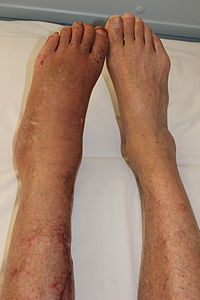
Photo from wikipedia
Masked uncontrolled hypertension (MUCH) is defined as controlled automated office blood pressure (BP; AOBP Click to show full abstract
Masked uncontrolled hypertension (MUCH) is defined as controlled automated office blood pressure (BP; AOBP <135/85 mm Hg) in-clinic in patients receiving antihypertensive medication(s) but uncontrolled BP out-of-clinic by 24-hour ambulatory BP monitoring (ABPM; awake ≥135/85 mm Hg). We hypothesized that MUCH patients have greater out-of-clinic sympathetic activity compared with true controlled hypertensives. Patients being treated for hypertension were prospectively recruited after 3 or more consecutive clinic visits. All patients were evaluated by in-clinic automated office BP, plasma catecholamines, and spot-urine/plasma metanephrines. In addition, out-of-clinic 24-hour ABPM, 24-hour urinary for catecholamines and metanephrines was done. Out of 237 patients recruited, 169 patients had controlled in-clinic BP of which 156 patients had completed ABPM. Seventy-four were true controlled hypertensives, that is controlled by clinic automated office BP and by out-of-clinic ABPM. The remaining 82 were controlled by clinic automated office BP, but uncontrolled during out-of-clinic ABPM, indicative of MUCH. After exclusion of 4 patients because of inadequate or lack of 24-hour urinary collections, 72 true controlled hypertensive and 80 MUCH patients were analyzed. MUCH patients had significantly higher out-of-clinic BP variability and lower heart rate variability compared with true controlled hypertensives, as well as higher levels of out-of-clinic urinary catecholamines and metanephrines levels consistent with higher out-of-clinic sympathetic activity. In contrast, there was no difference in in-clinic plasma catecholamines and spot-urine/plasma levels of metanephrines between the 2 groups, consistent with similar levels of sympathetic activity while in clinic. MUCH patients have evidence of heightened out-of-clinic sympathetic activity compared with true controlled hypertensives, which may contribute to the development of MUCH.
Journal Title: Hypertension
Year Published: 2019
Link to full text (if available)
Share on Social Media: Sign Up to like & get
recommendations!